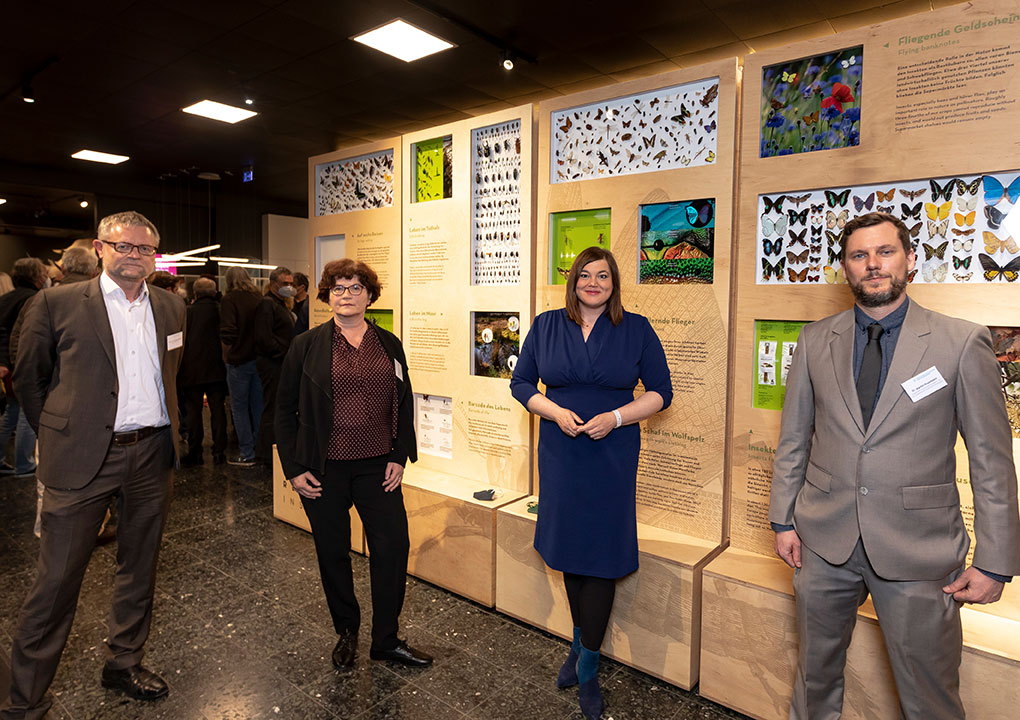“Multifaceted insects”: Travelling exhibition opens in Hamburg
Opening of the exhibition “Multifaceted Insects”: Prof. Dr Bernhard Misof, Director General LIB;
Sabine Riewenherm, President of the Federal Agency for Nature Conservation (BfN);
Katharina Fegebank, Second Mayor and Senator for Science and Research Hamburg;
Dr Martin Husemann, LIB insect specialist and project manager of the exhibition.
© LIB, Philipp Reiss
Dazzlingly beautiful, successful, useful – and threatened. Although insects do a great deal for us humans, we are responsible for their decline. From today, 23 March 2022, the travelling exhibition “Multifaceted Insects: Diversity I Endangerment I Protection” will be on display at the Zoological Museum in Hamburg and subsequently at other exhibition venues in Germany. Among other things, it explores the question of how we can better protect these fascinating animals.
“In order to preserve the diversity of insects and biodiversity in its entirety, we need a rethink in our society. The exhibition ‘Multifaceted Insects’ shows us that with the decline of insects we are not only losing the sight of colourful butterflies, but that our livelihoods are in danger,” emphasised Sabine Riewenherm, President of the Federal Agency for Nature Conservation (BfN), in her opening speech. The exhibition is part of the project “ProInsekt”, which is funded by the Federal Agency for Nature Conservation with funds from the Federal Ministry for the Environment in the Federal Programme Biodiversity and implemented by the Leibniz Institute for the Analysis of Biodiversity Change (LIB) in cooperation with NORe (Museumsverbund der Nord- und Ostsee Region e. V.).
“I am very pleased about the organisation of this exhibition,” emphasises Prof. Dr. Bernhard Misof, Director General of the Leibniz Institute for the Analysis of Biodiversity Change (LIB). “It reflects the entire spectrum of research at the LIB and prepares it for everyone to understand. At our locations in Hamburg and Bonn, as well as with partners around the world, we analyse the ways in which insects are endangered and why they are disappearing. We are intensively looking for solutions on how to protect insects and are engaging in dialogue with politicians and the public to this end.”
The decline of insect species has been documented in the Red Lists over many decades. The third volume of invertebrates published by the BfN a few days ago also shows that although populations of a few insect species have increased, the declines of many species clearly outweigh this. Five years ago, comprehensive studies on the massive loss of biomass made the drastic development a topic of public discussion, and a rethink began: In 2019, the German government adopted the so-called “Action Programme Insect Conservation”, API for short, the most effective and comprehensive package of measures to protect insects and their diversity. In addition, numerous research and protection programmes for insects were launched. What concrete measures are laid down in the API and what else is Germany doing to conserve insects – also in comparison to other countries? What do we now know about the life and habitats of the six-legged creatures – where do we lack information? How effective are measures in agriculture and in the private sphere?
The exhibition explores these questions: “Multifaceted Insects” outlines the causes and consequences of the massive decline in insect biomass and insect species. It shows what possibilities there are at the political and private level to stop the decline. Currently collected scientific data from the collections of the NORe museums involved in the development of the exhibition are included and show how the composition of the insect communities in northern Germany has changed and which species are currently endangered.
Katharina Fegebank, Second Mayor and Senator for Science and Research: “I am pleased that with ‘Multifaceted Insects’ we now have an interactive exhibition for young and old in Hamburg that provides exciting insights into our insect worlds and emphasises their relevance for biodiversity. The touring exhibition makes the multifaceted work of the LIB tangible for all Hamburgers and makes an important contribution to making the complex issues of our environment understandable to a broad public and raising awareness of ecological diversity.”
Background insects
Insects are the most species-rich group of animals. With their sophisticated behavioural strategies and diverse body features, they can be found in almost all habitats on earth. Their numerous abilities make them indispensable for ecosystems and also for our lives: Pollinators ensure good harvests, other insects help decompose manure, carcasses and dead plants. They are also an important food source for a variety of other animals. Accordingly, the decline of insects has serious consequences – also for humans.
Exhibition ‘Multifaceted Insects’
“Multifaceted Insects” will be shown in the museums of the NORe network until 2024 and will then travel to other exhibition venues in Germany. The touring exhibition addresses prejudices and takes all population and age groups on a journey of discovery into the world of this fascinating group of animals. With many hands-on and media stations, the exhibition is interactive and invites visitors to discover, be creative, listen and reflect on their own sphere of action. A diverse programme of education and events and an accompanying book complement the exhibition.
The exhibition was developed in the “ProInsekt” project and is funded by the Federal Agency for Nature Conservation (BfN) as part of the Federal Programme on Biological Diversity with funds from the Federal Ministry for the Environment, Nature Conservation, Nuclear Safety and Consumer Protection (BMUV) and the Deutsche Bundesstiftung Umwelt (DBU).
Further Information:
https://www.bfn.de/insektenrueckgang
Contact:
Leibniz Institute for the Analysis of Biodiversity Change (LIB)
Dr. Martin Husemann, Head of the project „ProInsekt” & section head of Hemimetabole und Hymenoptera
m.husemann@leibniz-lib.de
Press contact:
Mareen Gerisch
Head of Press & Communication, LIB Hamburg
m.gerisch@leibniz-lib.de



